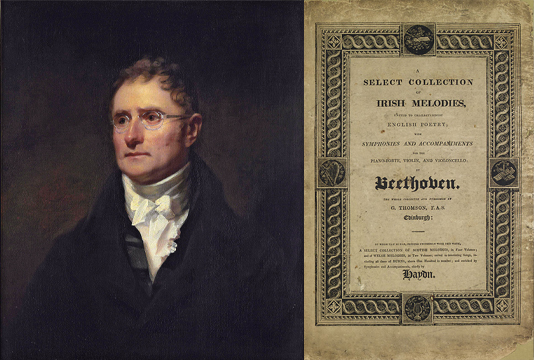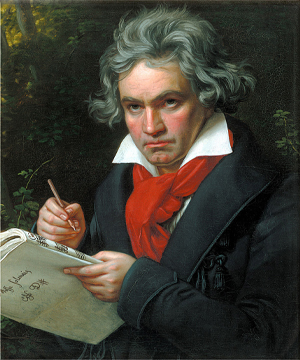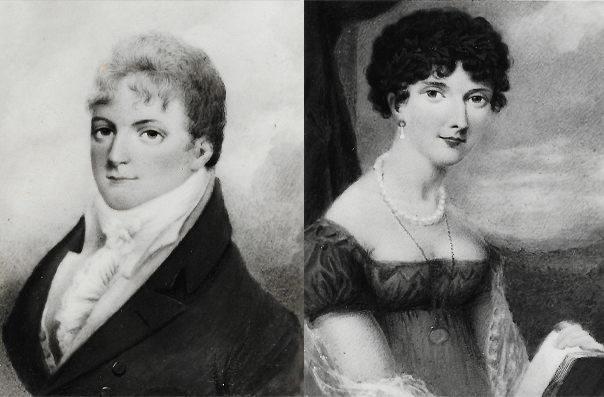BEETHOVEN’S ‘IMMORTAL BELOVED’—A POSSIBLE IRISH CONNECTION
Published in Features, Issue 6 (November/December 2022), Volume 30By Andreas Boldt
Ludwig van Beethoven (1770–1827), the German composer and pianist, is one of the most admired composers in the history of Western music. In his 30s Beethoven started to suffer hearing problems and by 1814 he had gone completely deaf. He gave up performing in public but continued to compose until his death in 1827. Not many documents give an insight into his personal troubled nature, but he did describe his problems with his health and unfulfilled personal life in two letters—the ‘Heiligenstatt Testament’ to his brothers (1802) and an unsent love-letter to an unknown ‘Immortal Beloved’ (possibly 1812).

Above: Between 1810 and 1813 the Scottish folk-song collector George Thomson commissioned Beethoven to compose the arrangements for 25 Irish folk-songs, published in 1814 as A select collection of Irish melodies (right).
But who was his ‘Immortal Beloved’, the woman who so besotted Beethoven that he was compelled to write one of the most infamously passionate and fervid love-letters ever written (although never sent)? Ever since the letter was discovered historians have tried to identify the mysterious woman, and several names have been suggested. Generally, there are five women in the frame—Dorothea von Ertmann, Amalie Sebald, Anna Marie Edödy, Therese Malfatti (it is believed that Für Elise was written in her honour) and Giulietta Guicciardi. Nevertheless, it has been impossible so far to prove which one of these women could be the ‘Immortal Beloved’. In the 1950s the watermarks of the paper were dated to around 1812 and heated discussions continued as to which one of these women had been in the spa village of Karlsbad (Bohemia) during the summer months of 1812, when Beethoven visited for treatments. The dating of the watermarks does not, however, prove that the letter was written in that same year.
During this time Beethoven had connections to Ireland. Between 1810 and 1813 the Scottish folk-song collector George Thomson (1757–1851) commissioned him to compose the arrangements for 25 Irish folk-songs. After Beethoven wrote the arrangements Thomson added the lyrics. They were published in 1814 in A select collection of Irish melodies. Amongst the songs one can find ‘The return to Ulster’ and ‘Oh harp of Erin’.
HELENA GRAVES
Beethoven, however, also had a personal connection to Ireland—and her name was Helena Graves. In 1806 Helena Perceval married John Crosbie Graves, chief police magistrate in Dublin and from a well-known Anglo-Irish family. The Percevals were an equally long-established family who had lived in Ireland for centuries. Helena supported her husband in his career, and in 1806, shortly after their marriage, Lord Redesdale, her patron, appointed Graves a commissioner of bankruptcy. Because of Helena’s reputed royal descent from several medieval kings of England (Edward I), Ireland (Dermot MacMurrough), Scotland (David I) and France (Charlemagne and Henry I), the Perceval name was widely adopted by the children.
Helena Graves liked to travel through Europe. During the early years of her marriage she had made several trips to England, France and Germany, where she met many famous people, the most renowned of whom was Beethoven. In her commonplace book the first notes begin in 1818, mentioning excerpts of personal letters of Beethoven to the German writer and novelist Bettina von Arnim (1785–1859). Further on, various compositions were mentioned, especially La ci darem la mano from Mozart’s Don Giovanni, evidently a favourite, as well as further details of Beethoven’s life, together with comments on his works and his opinion that Mozart’s Zauberflöte was the best opera.
PREGNANCY
Helena entertained a close relationship with Beethoven. During the summer of 1818 she travelled around in Germany and stayed in Karlsbad for a couple of weeks for a spa treatment. During her travels she also stopped at Mödling, south of Vienna, where Beethoven stayed for the summer months. When exactly they met we do not know, but it is possible to reconstruct that they had met several times in June and July. The famous ‘Immortal Beloved’ letter is dated 6 and 7 July (but without the year). While Helena Graves was by then 32 and had several children, she was highly educated thanks to her social background. She was also fluent in German. This is a similar profile to other mistresses of Beethoven. It is also noteworthy that Helena and her daughter Clarissa adored Beethoven’s music. There is a very high possibility that Helena Graves had an affair with Beethoven, and shortly after her visit she discovered that she was pregnant. Helena had not been accompanied during her travels by her husband, who was busy in Dublin dealing with the Irish economy. On her return to Ireland she was spurned by her husband, and she lived during the pregnancy with Stephen Rolleston (also described in correspondence at the time as a ‘patron’). It took a few months before she could return to Dublin again and it was weeks after the birth that John Crosbie Graves mentioned the newly born child, but only briefly, in a letter to his sister in June 1819. Caroline Henrietta Graves was never accepted by John, as she was not his child.
After Beethoven had struggled for a few years to come to terms with current musical trends, his work and output resumed shortly after Helena’s visit, and he began the first musical sketches that eventually formed part of his final Ninth Symphony. It appears that Helena may have inspired him.
CAROLINE GRAVES
Caroline Graves is usually omitted from the family history, and manuscripts in Trinity College, Dublin, reveal why. According to her letters, Caroline began to suffer a serious illness in the early 1830s. In later letters, especially between 1839 and 1842, her condition is described as very poor, with references to her losing her mind, becoming angry and shouting, and spending sleepless nights with ‘violent explosions of anger’. Then there were times when Caroline felt better again and was visited by her half-sister, Clarissa. At those times Caroline felt like a foolish girl, and she hoped to get better in body and mind ‘till I can learn to think and act for myself, which is very difficult’.
In most of Caroline’s letters it is difficult to decipher and make sense of her sentences, and therefore of her thoughts. From these symptoms it can be suggested that Caroline may have suffered from manic depression. Her sentences are usually quite accelerated and pressured and can be regarded as cognitive symptoms. She changed topics in mid-sentence or used irrelevant and idiosyncratic phrases. Although much of what she wrote was understandable to others, the accelerated and disjointed nature of her speech made it difficult to follow her train of thought and she sometimes seemed distracted by new and more exciting thoughts and ideas. Sometimes she seemed to be ‘high’ in mood and overactive in behaviour, and her judgement was poor.
In the more severe form of mania, the person is wildly excited, rants, raves (the stereotype of a wild ‘maniac’) and is constantly agitated and on the move. These symptoms aptly describe Caroline’s behaviour. Hallucinations and delusions may appear as a history of sleeplessness for long periods. Because some individuals may be uncontrollable and be frequently dangerous to themselves or to others, physical restraint and medication are often necessary. This was one of the reasons why physicians had to look after Caroline. Nevertheless, Caroline remained the favourite of the family siblings and was especially looked after by her half-sister Clarissa and her mother Helena.
These symptoms were also attributed to Beethoven and are another indicator that he may have been Caroline’s father, although it is difficult to prove. Caroline died in 1855 in a mental institution in England; a gravestone does not exist.
HELENA SEES BEETHOVEN AGAIN
Nevertheless, family problems could not keep Helena Graves away from Beethoven and she again visited him in Baden in May 1823. On this occasion we have more notes from her. She reported on numerous dinner parties, on moments when both played music, on how much Beethoven tended to forget and what foods he liked most. She also wrote down a little anecdote. She had dinner with Beethoven and his nephew, Anton Schindler, when a card was delivered from his brother, which was signed ‘Johann van Beethoven, landowner’. Ludwig immediately turned the card around and wrote on the back ‘Ludwig van Beethoven, brain owner’ and sent the card back. It was in summer 1823 that Beethoven would complete his Ninth Symphony.
Caroline’s half-sister, Clarissa, would at a later stage achieve some fame through her marriage to the German historian Leopold von Ranke (1795–1886). Her half-brother Charles Graves would become a lecturer at Trinity College, Dublin, president of the Royal Irish Academy and Church of Ireland bishop of Limerick. He made important contributions to research on the Brehon Laws and ogham script.
CONCLUSION
The case of Helena Graves is a suggested new addition to the puzzle of who may have been the ‘Immortal Beloved’ based on her descriptions, her pregnancy and the mental illness of her child. The dates of her visit and the following pregnancy would fit into the time-frame when the letters were dated (early July), with the only difference being the year (1818 and not 1812), although it is possible that Beethoven wrote the letter on older paper. I cannot prove that this was the case, however, and we may never know the truth for certain.
Andreas Boldt lectures in German and History at Maynooth University.
Further reading
A. Boldt, The role of Ireland in the life of Leopold von Ranke (1795–1886): the historian and historical truth (Lampeter, 2007).
B. Cooper, ‘Beethoven’s folksong settings as sources of Irish folk music’, in P. Devine and H. White (eds), Irish Musical Studies 5: The Maynooth International Musicological Conference 1995: selected proceedings, part 2 (Dublin, 1996), 65–81.
Manuscript collection of the Graves family, Trinity College, Dublin, ‘The commonplace book of Helena Graves’ (10047/27) and letters referring to Caroline Graves (10047/34 and 10047/36).


















